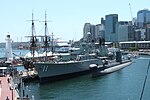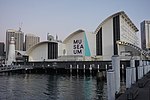HMAS Advance (P 83)

HMAS Advance (P 83) was an Attack-class patrol boat of the Royal Australian Navy (RAN). Constructed during 1967 and commissioned into the RAN in 1968, Advance operated from Darwin and patrolled northern Australian waters. During her career, the patrol boat shadowed a Soviet trawler, survived Cyclone Tracy, was used for filming of the television series Patrol Boat, and participated in the RAN's first anti-terrorism patrol of the North West Shelf. Advance was replaced in 1980, but continued to operate as a training ship until she was decommissioned in 1988. Advance was donated to the Australian National Maritime Museum, which has maintained her in an operational condition.
Excerpt from the Wikipedia article HMAS Advance (P 83) (License: CC BY-SA 3.0, Authors, Images).HMAS Advance (P 83)
Waterfront Promenade, Sydney Sydney
Geographical coordinates (GPS) Address Nearby Places Show on map
Geographical coordinates (GPS)
| Latitude | Longitude |
|---|---|
| N -33.869166666667 ° | E 151.19991666667 ° |
Address
HMAS Vampire
Waterfront Promenade
2000 Sydney, Sydney
New South Wales, Australia
Open on Google Maps










